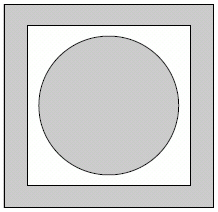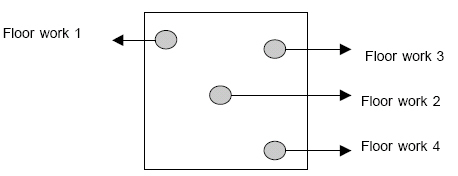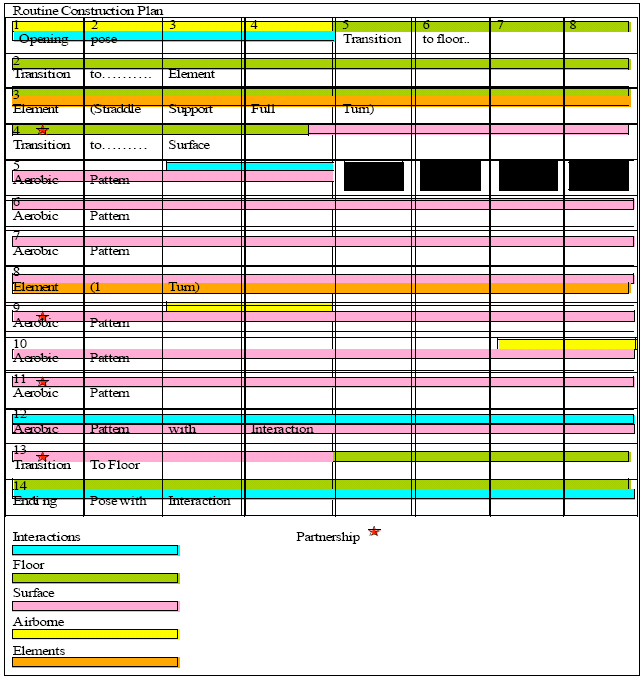- Aerobic movement patterns
- Difficulty Elements
- Transitions and linking
- Lifts (MP/TR/GR)
- Partnership (MP/TR/GR)
A.The Dynamism and fluency level of the whole routine (max. 1.0 point)
This means that all the movements that are presented in the routine, are linked without any unnecessary pauses, smoothly, in a dynamic way, with energy, with vigour, performed easily, without showing fatigue (laborious/hesitant) or heavily, showing agility and with a high intensity level.
Dynamic and fluent routines will be those that demonstrate the connection of all the routine components (AMP, elements, and partnership) using the transitions and linking with energy, agility, vigour, without excessive pauses, etc. In order to perform dynamic and fluent routines the performers will need as a pre-requisite an excellent physical condition and an excellent skill technique which allows the gymnasts to perform the routine without interruption, hesitation, and smoothly throughout the whole routine, without showing fatigue.
Common Errors (examples)
- Stop before or after a movement
- Making excessive poses on the floor and/or on the surface
- Not connecting the three competition levels in a dynamic way or diminish the intensity, endurance, speed and frequency of movements
- The members of a MP-TR-GR do not change formations and the position in the formations fluently
- Mounting and dismounting from lifts not fluent or showing hesitation or pause
SCALE
|
Excellent
|
The whole routine is dynamic and fluent showing all the characteristics of the criteria mentioned above. |
|
Very
Good
|
The routine deviates a little from excellent level showing small errors in the criteria. |
|
Good
|
The routine shows medium errors of deviation from the criteria. |
|
Satisfactory
|
The routine shows large errors of deviation from the criteria. |
|
Poor
|
The level of dynamism and fluency is unacceptable for an Aerobic Gymnastics Routine. |
B. The Complexity and Creativity level of these movements (max. 1.0 point)
A creative composition of the routine means that it has been constructed and is performed creating meaningful new ideas, forms, interpretations, originality, progressiveness, or imagination, with unique and creative characteristics avoiding copying and monotony.
It is more difficult to perform complex and creative movements than simples ones. It requires more coordination, more physical conditioning, better body control, etc.
A simple movement is one that you can do immediately after seeing it, without any training. A complex and creative movement is one that you need a certain period of time to perform and requires coordination and a previous preparation (physical conditioning, biomechanical analysis, analytic and systematic analysis, progressions…..)
The artistic score should reflect the complexity and creativity level of all these movements. When a movement is more complex and creative than others,
- It requires more coordination:
- more body parts are involved
-the use of asymmetry
- change of plane and levels
- change of orientation
- formation changes in MP, TR and GR
- has rhythm changes and different rhythm between upper and lower body
- It needs more PHYSICAL CAPACITIES training (it requires more physical capacities to perform it)
- It is faster. Needs more energy and is more dynamic
- Has more frequency
- It is different to other movements (It is easier to perform movements showing only one physical capacity) - It is sudden. Unpredictable
Complex and creative routines are very hard to perform, and they should be more highly awarded. The athlete who takes this option should benefit.
- Easier movements = lower score
- More complex and creative movements = higher score
The artistic judges will evaluate under these criteria the following movements:
- Transitions
- Linking
- Physical Interaction
- Lifts
- Formations
- Partnership
The complexity and creativity of AMP sequences will be evaluated under the point 2 Aerobic Content.
The complexity of the Difficulty elements are evaluated by the difficulty tables and is by Difficulty judges.
Complex and creative routines will be those that shown a high level of body coordination, technical skill and physical capacities of the performers.
The complexity and creativity level of the movements must be shown by all the members of the MP, TR and GR, and be demonstrated in all the movements included in the competition routine (linking, transition, physical interaction, lifts and formation)
Complex and creative routines include many details to enhance the quality of the routine, integration of all members in MP-TR-GR.
In order to have Complex / Creative lifts; judges will apply the following criteria
Base: the competitor who is holding another competitor
Top: the competitor who is being held by his/her partner
• A lift can be different from another if the position of the top(s) and base(s) are different in each lift (i.e. base standing, kneeling, seating, lying, front support, etc…., and top in straddle support, planche, vertical split, frontal split, etc….)
• If the position of the top(s) change during the lift • If the position of the base(s) change during the lift
• Varying the number of bases in each lift (i.e. in trio 1st lift 1 partner lift 2 partners, 2nd lift 2 partners lift 1 partner, 3rd lift two partners lift 1 partner but alternatively without the lifted person touching the floor until the completion of the lift.
1. Showing different levels of the lifted partner in relation to the shoulder axis (under or above the shoulders).
2. Showing the strength and/or flexibility and/or balance of the competitors.
3. Changing the form during the movement: the position of a lifted person(s) shows various forms. • Varying the kind of lifts (static lifts vs dynamic lifts)
Common Errors (examples)
• Showing complex / creative movements only in the upper limbs while at the same time the leg action is not complex;
• Transitions that require only the use of one single physical capacity (example Strength)
• Performing in the routine only complex / creative transitions from the floor to surface and showing simple transitions from the surface/airborne to floor (the competitor only goes to the floor using difficulty elements landing in PU or split positions)
• The movements are easily executed by other competitors after seeing them only once.
• The linking between difficulty elements is simple
• The transitions for changing levels are easy • Copying
• No creative partnership and physical interactions
• Connecting elements from/to AMP without complex / creative transitions or linking
• Connecting elements together without complex / creative transitions or linking
• Changing levels only with difficulty elements
• Use of simple lifts
SCALE
|
Excellent
|
The whole routine is complex and creative showing all the characteristics of the criteria mentioned above.
|
|
Very
Good
| The routine deviates a little from excellent level showing small errors in the criteria.
|
|
Good | The routine shows medium errors of deviation from the criteria.
|
|
Satisfactory
| The routine shows large errors of deviation from the criteria.
|
|
Poor
| The level of complexity and creativity is unacceptable for an Aerobic Gymnastics Routine.
|
C. The Selection of the movements showing Variety (max. 1.0 point)
The Artistic judges evaluate the variety of:
- Transitions
- Linking
- Formations
- Lifts
- Physical Interactions
- Partnership
Aerobic gymnastics routines must show a well balanced selection of all movements, in order to enhance the routine and the competitor(s) Characteristics and style.
To evaluate the variety of the routines, the artistic judges will take into consideration that all of these movements must be without repetition or reiteration of the same or similar types of movements.
All of them should include different actions, different forms, and different types of movements, different physical capacities, during the performing of the transitions, linking, lifts, partnerships, and physical interactions and other moves.
Excellent routines must show a great amount of different types of movements
Common Errors (examples)
- Repetition of the same kind of transitions (they are similar or look very similar)
- Repetition of the same kind of lifts without using the criteria
- Monotonous movements
- Repetition of poses (they are similar or look very similar)
- Repetition of partnership
- Repeating sim i l ar types of transitions or linking
- Repetition of similar types of lifts
SCALE
|
Excellent | The whole routine is with variety showing all the characteristics of the criteria mentioned above
|
|
Very
Good | The routine deviates a little from excellent level showing small errors in the criteria.
|
|
Good
| The routine shows medium errors of deviation from the criteria.
|
|
Satisfactory | The routine shows large errors of deviation from the criteria.
|
|
Poor | The level of variety is unacceptable for an Aerobic Gymnastics Routine.
|
D. The Effective use of the competition space and placement of all these movements in the routine (max. 1.0 point)

2. Throughout the routine, travelling must be shown in all directions (forward, backward, laterally, diagonally and circular) and long and short distances, with as little repetition of traces/tracks (this means For example trying to go in one direction travelling laterally from right to left and then later to do another lateral travel from left to right, this will be ok, if it is repeated again right to left in lateral travelling, this will not be good. The same with diagonals, etc……)
3. All three levels (floor-work, standing, airborne) of the competition space must be used, without any predominating level throughout the routine

The movements must be placed throughout the routine in a balanced way.
Excellent routines must use effectively the competition spa ce (to the maxi m u m) in al l the aspe cts mentioned above, in a balanced way, using the distance between competitors (far – close) in the competition spa ce (MP-TR-GR)
Common Errors (examples)
- Performing only in the narrow range area without making effective use of the space.
- A predominated use of the competition area
- Many similar travelling traces/tracks (locus) are seen.
- With aerobic movement patterns, the competitor(s) did not travel in a variety of distances in different directions.
- Performing in one level for a long time.
- Predominating in one level.

|
Excellent
| The use of the competition space and the placement is used to enhance the routine to the maximum showing all the characteristics of the criteria mentioned above.
|
|
Very
Good
| The routine deviates a little from excellent level showing small errors in the criteria.
|
|
Good | The routine shows medium errors of deviation from the criteria.
|
|
Satisfactory
| The routine shows large errors of deviation from the criteria.
|
|
Poor
| The use of the competition space and the placement is unacceptable for an Aerobic Gymnastics Routine.
|






